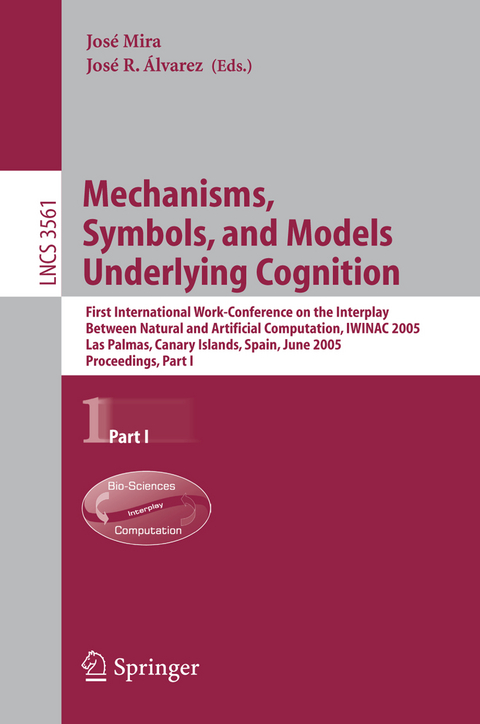
Mechanisms, Symbols, and Models Underlying Cognition
Springer Berlin (Verlag)
978-3-540-26298-5 (ISBN)
Computational Neuroscience.- On the Use of the Computational Paradigm in Neurophysiology and Cognitive Science.- Modules, Layers, Hierarchies, and Loops Where Artificial Intelligence Meets Ethology and Neuroscience - In Context of Action Selection.- A Unified Perspective on Explaining Dynamics by Anticipatory State Properties.- A Novel Intrinsic Wave Phenomenon in Low Excitable Biological Media.- Conceptual Idea of Natural Mechanisms of Recognition, Purposeful Thinking and Potential of Its Technical Application.- Simulation of Orientation Contrast Sensitive Cell Behavior in TiViPE.- Formulation and Validation of a Method for Classifying Neurons from Multielectrode Recordings.- Gap-Junctions Promote Synchrony in a Network of Inhibitory Interneurons in the Presence of Heterogeneities and Noise.- A Conceptual Model of Amphibian's Tectum Opticum with Probabilistic Coded Outputs.- Realistic Stimulation Through Advanced Dynamic-Clamp Protocols.- Interacting Slow and Fast Dynamics in Precise Spiking-Bursting Neurons.- An Integral Model of Spreading Depression: From Neuron Channels to Field Potentials.- Separation of Extracellular Spikes: When Wavelet Based Methods Outperform the Principle Component Analysis.- Structural Statistical Properties of the Connectivity Could Underlie the Difference in Activity Propagation Velocities in Visual and Olfactory Cortices.- Rules and Roles of Dendritic Spikes in CA1 Pyramidal Cells: A Computational Study.- Slow Conductances Encode Stimulus History into Spike Shapes.- Comparison of Plasticity of Self-optimizing Neural Networks and Natural Neural Networks.- Evaluation of Neuronal Firing Densities via Simulation of a Jump-Diffusion Process.- Gaussian Processes and Neuronal Modeling.- On the Moments of Firing Numbers in Diffusion NeuronalModels with Refractoriness.- Fluctuation Dynamics in Electroencephalogram Time Series.- Modelling of Dysfunctions in the Neuronal Control of the Lower Urinary Tract.- Coding Strategies in Early Stages of the Somatosensory System.- Auditory Nerve Encoding of High-Frequency Spectral Information.- Multielectrode Analysis of Information Flow Through Cat Primary Visual Cortex.- Bioinspired Computation.- Towards Evolutionary DNA Computing.- A Linear Solution of Subset Sum Problem by Using Membrane Creation.- A Study of the Robustness of the EGFR Signalling Cascade Using Continuous Membrane Systems.- A Tool for Implementing and Exploring SBM Models: Universal 1D Invertible Cellular Automata.- Network of Evolutionary Processors with Splicing Rules.- Network of Evolutionary Processors with Splicing Rules and Forbidding Context.- A Multiplexed Current Source Portable Stimulator Architecture for a Visual Cortical Neuroprosthesis.- An Augmented Reality Visual Prothesis for People Affected by Tunneling Vision.- Eye Tracking in Coloured Image Scenes Represented by Ambisonic Fields of Musical Instrument Sounds.- Tasks Modelling at the Knowledge Level.- Avoidance Behavior Controlled by a Model of Vertebrate Midbrain Mechanisms.- Transition Cells and Neural Fields for Navigation and Planning.- Spatial Navigation Based on Novelty Mediated Autobiographical Memory.- Vision and Grasping: Humans vs. Robots.- Evolved Neural Reflex-Oscillators for Walking Machines.- A Haptic System for the Lucs Haptic Hand I.- Action-Based Cognition: How Robots with No Sensory System Orient Themselves in an Open Field Box.- A Robotics Inspired Method of Modeling Accessible Open Space to Help Blind People in the Orientation and Traveling Tasks.- A Scientific Point of View on Perceptions.- Reasoning by Assumption: Formalisation and Analysis of Human Reasoning Traces.- Aligning Reference Terminologies and Knowledge Bases in the Health Care Domain.- Predicting Mortality in the Intensive Care Using Episodes.- A Fuzzy Temporal Diagnosis Algorithm and a Hypothesis Discrimination Proposal.- Spatial Reasoning Based on Rules.- Key Aspects of the Diagen Conceptual Model for Medical Diagnosis.- Connectionist Contribution to Building Real-World Ontologies.- Self Assembling Graphs.- Knowledge Modeling for the Traffic Sign Recognition Task.- Interval-Valued Neural Multi-adjoint Logic Programs.
| Erscheint lt. Verlag | 9.6.2005 |
|---|---|
| Reihe/Serie | Lecture Notes in Computer Science | Theoretical Computer Science and General Issues |
| Zusatzinfo | XXIV, 532 p. |
| Verlagsort | Berlin |
| Sprache | englisch |
| Maße | 155 x 235 mm |
| Gewicht | 776 g |
| Themenwelt | Informatik ► Software Entwicklung ► User Interfaces (HCI) |
| Informatik ► Theorie / Studium ► Algorithmen | |
| Naturwissenschaften ► Biologie ► Evolution | |
| Schlagworte | Algorithm analysis and problem complexity • Artificial Neural Networks • augmented reality • Automata • bio-inspired computing • brain-like computing • cognitive science • Computational Neuroscience • evolutionary algorithms • Genetic algorithms • Intelligence • neural classifier systems • neural computing • neural learning • Neural networks • neuronal modelling • Neuroscience • Robotics • Simulation • Spin |
| ISBN-10 | 3-540-26298-9 / 3540262989 |
| ISBN-13 | 978-3-540-26298-5 / 9783540262985 |
| Zustand | Neuware |
| Haben Sie eine Frage zum Produkt? |
aus dem Bereich


